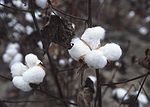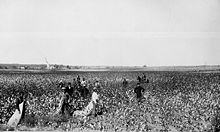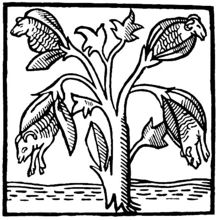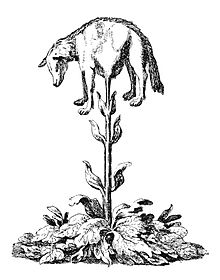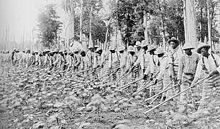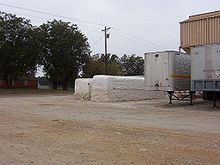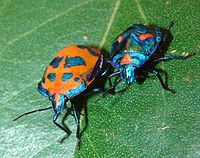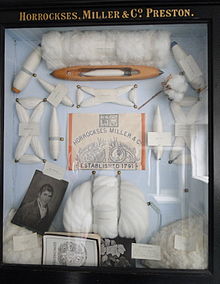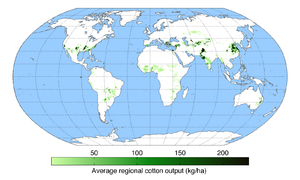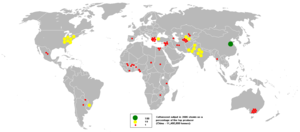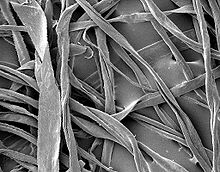- Cotton
-
Cotton History of cotton Terms Cash crop
Commodity
Cottonopolis
Cotton Belt
Cotton diplomacy
King CottonTypes Gossypium hirsutum
Gossypium barbadense
Gossypium arboreum
Gossypium herbaceum
Organic cottonProduction Cotton-spinning machinery
Cotton gin
Cotton mill
Cotton picker
Mercerised cotton
Spinning jenny
Spinning mule
Spinning wheel
Water frameFabric Chambray
Corduroy
Denim
Seersucker
Terryclothv · Cotton bolls ready for harvest
Cotton is a soft, fluffy staple fiber that grows in a boll, or protective capsule, around the seeds of cotton plants of the genus Gossypium. The fiber is almost pure cellulose. The botanical purpose of cotton fiber is to aid in seed dispersal.
The plant is a shrub native to tropical and subtropical regions around the world, including the Americas, Africa, and India. The greatest diversity of wild cotton species is found in Mexico, followed by Australia and Africa.[1] Cotton was independently domesticated in the Old and New Worlds. The English name derives from the Arabic (al) qutn قُطْن, which began to be used circa 1400 AD.[2]
The fiber most often is spun into yarn or thread and used to make a soft, breathable textile. The use of cotton for fabric is known to date to prehistoric times; fragments of cotton fabric dated from 5000 BC have been excavated in Mexico and Pakistan. Although cultivated since antiquity, it was the invention of the cotton gin that so lowered the cost of production that led to its widespread use, and it is the most widely used natural fiber cloth in clothing today.
Current estimates for world production are about 25 million tonnes annually, accounting for 2.5% of the world's arable land. China is the world's largest producer of cotton, but most of this is used domestically. The United States has been the largest exporter for many years.[3]
Contents
Types of cotton
There are four commercially-grown species of cotton, all domesticated in antiquity:
- Gossypium hirsutum – upland cotton, native to Central America, Mexico, the Caribbean and southern Florida, (90% of world production)
- Gossypium barbadense – known as extra-long staple cotton, native to tropical South America (8% of world production)
- Gossypium arboreum – tree cotton, native to India and Pakistan (less than 2%)
- Gossypium herbaceum – Levant cotton, native to southern Africa and the Arabian Peninsula (less than 2%)
The two New World cotton species account for the vast majority of modern cotton production, but the two Old World species were widely used before the 1900s. While cotton fibers occur naturally in colors of white, brown, and green, fears of contaminating the genetics of white cotton has led many cotton-growing locations to ban growing of colored cotton varieties which remain a specialty product.
History
Main article: History of cottonCotton fabrics discovered in a cave near Tehuacán, Mexico have been dated to around 5800 BC, although it is difficult to know for certain due to fiber decay.[4] Other sources date the domestication of cotton in Mexico to approximately 5000 to 3000 BC.[5]
Cotton was first cultivated in the Old World 7,000 years ago (5th millennium BC), by the inhabitants of western Pakistan, for example as the site of Mehrgarh where early cotton thread has been preserved in copper beads [6]. Cotton cultivation became more widespread during the Indus Valley Civilization, which covered a huge swath of the northwestern part of the South Asia, comprising today parts of eastern Pakistan and northwestern India.[7] The Indus cotton industry was well developed and some methods used in cotton spinning and fabrication continued to be used until the modern industrialization of India.[8]. Between 2000 and 1000 BC cotton became widespread in much of India[9]. For example, it has been found at the site of Hallus in Karnataka around 1000 BC. Well before the Common Era, the use of cotton textiles had spread from India to the Mediterranean and beyond.[10]
The Greeks and the Arabs were not familiar with cotton until the Wars of Alexander the Great, as his contemporary Megasthenes told Seleucus I Nicator of "there being trees on which wool grows" in "Indica".
According to the Columbia Encyclopedia, sixth edition:[11]
Cotton has been spun, woven, and dyed since prehistoric times. It clothed the people of ancient India, Egypt, and China. Hundreds of years before the Christian era, cotton textiles were woven in India with matchless skill, and their use spread to the Mediterranean countries.In Iran (Persia), the history of cotton dates back to the Achaemenid era (5th century BC); however, there are few sources about the planting of cotton in pre-Islamic Iran. The planting of cotton was common in Merv, Ray and Pars of Iran. In the poems of Persian poets, especially Ferdowsi's Shahname, there are references to cotton ("panbe" in Persian). Marco Polo (13th century) refers to the major products of Persia, including cotton. John Chardin, a French traveler of 17th century, who had visited the Safavid Persia, has approved the vast cotton farms of Persia.[12]
During the Han dynasty, cotton was grown by non Chinese peoples in the southern Chinese province of Yunnan.[13]
In Peru, cultivation of the indigenous cotton species Gossypium barbadense was the backbone of the development of coastal cultures, such as the Norte Chico, Moche and Nazca. Cotton was grown upriver, made into nets and traded with fishing villages along the coast for large supplies of fish. The Spanish who came to Mexico and Peru in the early 16th century found the people growing cotton and wearing clothing made of it.
During the late medieval period, cotton became known as an imported fiber in northern Europe, without any knowledge of how it was derived, other than that it was a plant; noting its similarities to wool, people in the region could only imagine that cotton must be produced by plant-borne sheep. John Mandeville, writing in 1350, stated as fact the now-preposterous belief: "There grew there [India] a wonderful tree which bore tiny lambs on the endes of its branches. These branches were so pliable that they bent down to allow the lambs to feed when they are hungrie [sic]." (See Vegetable Lamb of Tartary.) This aspect is retained in the name for cotton in many European languages, such as German Baumwolle, which translates as "tree wool" (Baum means "tree"; Wolle means "wool"). By the end of the 16th century, cotton was cultivated throughout the warmer regions in Asia and the Americas.
India's cotton-processing sector gradually declined during British expansion in India and the establishment of colonial rule during the late 18th and early 19th centuries. This was largely due to aggressive colonialist mercantile policies of the British East India Company, which made cotton processing and manufacturing workshops in India uncompetitive. Indian markets were increasingly forced to supply only raw cotton and were forced, by British-imposed law, to purchase manufactured textiles from Britain.
Industrial Revolution in Britain
The advent of the Industrial Revolution in Britain provided a great boost to cotton manufacture, as textiles emerged as Britain's leading export. In 1738, Lewis Paul and John Wyatt, of Birmingham, England, patented the roller spinning machine, and the flyer-and-bobbin system for drawing cotton to a more even thickness using two sets of rollers that traveled at different speeds. Later, the invention of the spinning jenny in 1764 and Richard Arkwright's spinning frame (based on the roller spinning machine) in 1769 enabled British weavers to produce cotton yarn and cloth at much higher rates. From the late 18th century onwards, the British city of Manchester acquired the nickname "Cottonopolis" due to the cotton industry's omnipresence within the city, and Manchester's role as the heart of the global cotton trade. Production capacity in Britain and the United States was improved by the invention of the cotton gin by the American Eli Whitney in 1793. Improving technology and increasing control of world markets allowed British traders to develop a commercial chain in which raw cotton fibers were (at first) purchased from colonial plantations, processed into cotton cloth in the mills of Lancashire, and then exported on British ships to captive colonial markets in West Africa, India, and China (via Shanghai and Hong Kong).
By the 1840s, India was no longer capable of supplying the vast quantities of cotton fibers needed by mechanized British factories, while shipping bulky, low-price cotton from India to Britain was time-consuming and expensive. This, coupled with the emergence of American cotton as a superior type (due to the longer, stronger fibers of the two domesticated native American species, Gossypium hirsutum and Gossypium barbadense), encouraged British traders to purchase cotton from plantations in the United States and the Caribbean. By the mid-19th century, "King Cotton" had become the backbone of the southern American economy. In the United States, cultivating and harvesting cotton became the leading occupation of slaves.
During the American Civil War, American cotton exports slumped due to a Union blockade on Southern ports, also because of a strategic decision by the Confederate government to cut exports, hoping to force Britain to recognize the Confederacy or enter the war, prompting the main purchasers of cotton, Britain and France to turn to Egyptian cotton. British and French traders invested heavily in cotton plantations and the Egyptian government of Viceroy Isma'il took out substantial loans from European bankers and stock exchanges. After the American Civil War ended in 1865, British and French traders abandoned Egyptian cotton and returned to cheap American exports, sending Egypt into a deficit spiral that led to the country declaring bankruptcy in 1876, a key factor behind Egypt's annexation by the British Empire in 1882.
During this time, cotton cultivation in the British Empire, especially India, greatly increased to replace the lost production of the American South. Through tariffs and other restrictions, the British government discouraged the production of cotton cloth in India; rather, the raw fiber was sent to England for processing. The Indian Mahatma Gandhi described the process:
- English people buy Indian cotton in the field, picked by Indian labor at seven cents a day, through an optional monopoly.
- This cotton is shipped on British ships, a three-week journey across the Indian Ocean, down the Red Sea, across the Mediterranean, through Gibraltar, across the Bay of Biscay and the Atlantic Ocean to London. One hundred per cent profit on this freight is regarded as small.
- The cotton is turned into cloth in Lancashire. You pay shilling wages instead of Indian pennies to your workers. The English worker not only has the advantage of better wages, but the steel companies of England get the profit of building the factories and machines. Wages; profits; all these are spent in England.
- The finished product is sent back to India at European shipping rates, once again on British ships. The captains, officers, sailors of these ships, whose wages must be paid, are English. The only Indians who profit are a few lascars who do the dirty work on the boats for a few cents a day.
- The cloth is finally sold back to the kings and landlords of India who got the money to buy this expensive cloth out of the poor peasants of India who worked at seven cents a day. (Fisher 1932 pp 154–156)
In the United States, Southern cotton provided capital for the continuing development of the North. The cotton produced by enslaved African Americans not only helped the South, but also enriched Northern merchants. Much of the Southern cotton was transshipped through the northern ports.
Cotton remained a key crop in the Southern economy after emancipation and the end of the Civil War in 1865. Across the South, sharecropping evolved, in which free black farmers and landless white farmers worked on white-owned cotton plantations of the wealthy in return for a share of the profits. Cotton plantations required vast labor forces to hand-pick cotton, and it was not until the 1950s that reliable harvesting machinery was introduced into the South (prior to this, cotton-harvesting machinery had been too clumsy to pick cotton without shredding the fibers). During the early 20th century, employment in the cotton industry fell, as machines began to replace laborers, and the South's rural labor force dwindled during the First and Second World Wars. Today, cotton remains a major export of the southern United States, and a majority of the world's annual cotton crop is of the long-staple American variety.[14]
Tangüis cotton

In 1901, Peru's cotton industry suffered because of a fungus plague caused by a plant disease known as "cotton wilt" or, more correctly, "fusarium wilt", caused by the fungus Fusarium vasinfectum.[15] The plant disease, which spread throughout Peru, entered plant's roots and worked its way up the stem until the plant was completely dried up. Fermín Tangüis, a Puerto Rican agriculturist who lived in Peru, studied some species of the plant that were affected by the disease to a lesser extent and experimented in germination with the seeds of various cotton plants. In 1911, after 10 years of experimenting and failures, Tangüis was able to develop a seed which produced a superior cotton plant resistant to the disease. The seeds produced a plant that had a 40% longer (between 29 mm and 33 mm) and thicker fiber that did not break easily and required little water.[16] The Tangüis cotton, as it became known, is the variety which is preferred by the Peruvian national textile industry. It constituted 75% of all the Peruvian cotton production, both for domestic use and apparel exports. The Tangüis cotton crop was estimated at 225,000 bales that year.[17]
Cultivation
Successful cultivation of cotton requires a long frost-free period, plenty of sunshine, and a moderate rainfall, usually from 600 to 1200 mm (24 to 48 inches). Soils usually need to be fairly heavy, although the level of nutrients does not need to be exceptional. In general, these conditions are met within the seasonally dry tropics and subtropics in the Northern and Southern hemispheres, but a large proportion of the cotton grown today is cultivated in areas with less rainfall that obtain the water from irrigation. Production of the crop for a given year usually starts soon after harvesting the preceding autumn. Planting time in spring in the Northern hemisphere varies from the beginning of February to the beginning of June. The area of the United States known as the South Plains is the largest contiguous cotton-growing region in the world. While dryland (non-irrigated) cotton is successfully grown in this region, consistent yields are only produced with heavy reliance on irrigation water drawn from the Ogallala Aquifer. Since cotton is somewhat salt and drought tolerant, this makes it an attractive crop for arid and semiarid regions. As water resources get tighter around the world, economies that rely on it face difficulties and conflict, as well as potential environmental problems.[18][19][20][21][22] For example, improper cropping and irrigation practices have led to desertification in areas of Uzbekistan, where cotton is a major export. In the days of the Soviet Union, the Aral Sea was tapped for agricultural irrigation, largely of cotton, and now salination is widespread.[21][22]
Cotton can also be cultivated to have colors other than the yellowish off-white typical of modern commercial cotton fibers. Naturally colored cotton can come in red, green, and several shades of brown.[23]
Genetic modification
Genetically modified (GM) cotton was developed to reduce the heavy reliance on pesticides. The bacterium Bacillus thuringiensis (Bt) naturally produces a chemical harmful only to a small fraction of insects, most notably the larvae of moths and butterflies, beetles, and flies, and harmless to other forms of life. The gene coding for Bt toxin has been inserted into cotton, causing cotton to produce this natural insecticide in its tissues. In many regions, the main pests in commercial cotton are lepidopteran larvae, which are killed by the Bt protein in the transgenic cotton they eat. This eliminates the need to use large amounts of broad-spectrum insecticides to kill lepidopteran pests (some of which have developed pyrethroid resistance). This spares natural insect predators in the farm ecology and further contributes to noninsecticide pest management.
Bt cotton is ineffective against many cotton pests, however, such as plant bugs, stink bugs, and aphids; depending on circumstances it may still be desirable to use insecticides against these. A 2006 study done by Cornell researchers, the Center for Chinese Agricultural Policy and the Chinese Academy of Science on Bt cotton farming in China found that after seven years these secondary pests that were normally controlled by pesticide had increased, necessitating the use of pesticides at similar levels to non-Bt cotton and causing less profit for farmers because of the extra expense of GM seeds.[24] However a more recent 2009 study by the Chinese Academy of Sciences, Stanford University and Rutgers University refutes this.[25] They concluded that the GM cotton effectively controlled bollworm. The secondary pests were mostly miridae (plant bugs) whose increase was related to local temperature and rainfall and only continued to increase in half the villages studied. Moreover, the increase in insecticide use for the control of these secondary insects was far smaller than the reduction in total insecticide use due to Bt cotton adoption. The International Service for the Acquisition of Agri-biotech Applications (ISAAA) said that, worldwide, GM cotton was planted on an area of 16 million hectares in 2009.[26] This was 49% of the worldwide total area planted in cotton. The U.S. cotton crop was 93% GM in 2010[27] and the Chinese cotton crop was 68% GM in 2009.[28]
The initial introduction of GM cotton proved to be a success in Australia - the yields were equivalent to the no transgenic varieties and the crop used much less pesticide to produce (85% reduction).[29] The subsequent introduction of a second variety of GM cotton led to increases in GM cotton production until 95% of the Australian cotton crop was GM in 2009.[26]
Cotton has mainly been genetically modified for resistance to glyphosate (marketed as Roundup in North America) a broad-spectrum herbicide sold by Monsanto, the same company that sells some of the Bt cotton seeds to farmers.[30] There are now a number of different cotton seed companies selling GE cotton around the world. Farmers buy new seed every year under a licensing agreement between the farmer and the company that has created the GE cotton.[citation needed]
GM cotton acreage in India continues to grow at a rapid rate, increasing from 50,000 hectares in 2002 to 8.4 million hectares in 2009. The total cotton area in India was 9.6 million hectares (the largest in the world or, about 35% of world cotton area), so GM cotton was grown on 87% of the cotton area in 2009.[28] This makes India the country with the largest area of GM cotton in the world, surpassing China (3.7 million hectares in 2009). The major reasons for this increase is a combination of increased farm income ($225/ha) and a reduction in pesticide use to control the cotton bollworm.
Cotton has gossypol, a toxin that makes it inedible. However, scientists have silenced the gene that produces the toxin, making it a potential food crop.[31]
Organic production
Organic cotton is generally understood as cotton, from plants not genetically modified, that is certified to be grown without the use of any synthetic agricultural chemicals, such as fertilizers or pesticides.[32] Its production also promotes and enhances biodiversity and biological cycles.[33] United States cotton plantations are required to enforce the National Organic Program (NOP). This institution determines the allowed practices for pest control, growing, fertilizing, and handling of organic crops.[34][35] As of 2007, 265,517 bales of organic cotton were produced in 24 countries, and worldwide production was growing at a rate of more than 50% per year.[36]
Pests and weeds
The cotton industry relies heavily on chemicals, such as herbicides, fertilizers and insecticides, although a very small number of farmers are moving toward an organic model of production, and organic cotton products are now available for purchase at limited locations. These are popular for baby clothes and diapers. Under most definitions, organic products do not use genetic engineering.
Historically, in North America, one of the most economically destructive pests in cotton production has been the boll weevil. Due to the US Department of Agriculture's highly successful Boll Weevil Eradication Program (BWEP), this pest has been eliminated from cotton in most of the United States. This program, along with the introduction of genetically engineered Bt cotton (which contains a bacterial gene that codes for a plant-produced protein that is toxic to a number of pests such as cotton bollworm and pink bollworm), has allowed a reduction in the use of synthetic insecticides.
Other significant global pests of cotton include the pink bollworm, Pectinophora gossypiella; the chili thrips, Scirtothrips dorsalis; the cotton seed bug, Oxycarenus hyalinipennis; the tarnish plant bug, Lygus lineolaris; and the fall armyworm, Spodoptera frugiperda.
Harvesting
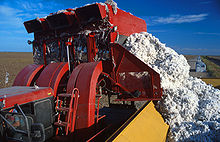 Offloading freshly harvested cotton into a module builder in Texas; previously built modules can be seen in the background
Offloading freshly harvested cotton into a module builder in Texas; previously built modules can be seen in the background
Most cotton in the United States, Europe, and Australia is harvested mechanically, either by a cotton picker, a machine that removes the cotton from the boll without damaging the cotton plant, or by a cotton stripper, which strips the entire boll off the plant. Cotton strippers are used in regions where it is too windy to grow picker varieties of cotton, and usually after application of a chemical defoliant or the natural defoliation that occurs after a freeze. Cotton is a perennial crop in the tropics, and without defoliation or freezing, the plant will continue to grow.
Cotton continues to be picked by hand in developing countries.[37]
Competition from synthetic fibers
The era of manufactured fibers began with the development of rayon in France in the 1890s. Rayon is derived from a natural cellulose and cannot be considered synthetic, but requires extensive processing in a manufacturing process, and led the less expensive replacement of more naturally derived materials. A succession of new synthetic fibers were introduced by the chemicals industry in the following decades. Acetate in fiber form was developed in 1924. Nylon, the first fiber synthesized entirely from petrochemicals, was introduced as a sewing thread by DuPont in 1936, followed by DuPont's acrylic in 1944. Some garments were created from fabrics based on these fibers, such as women's hosiery from nylon, but it was not until the introduction of polyester into the fiber marketplace in the early 1950s that the market for cotton came under threat.[38] The rapid uptake of polyester garments in the 1960s caused economic hardship in cotton-exporting economies, especially in Central American countries, such as Nicaragua, where cotton production had boomed tenfold between 1950 and 1965 with the advent of cheap chemical pesticides. Cotton production recovered in the 1970s, but crashed to pre-1960 levels in the early 1990s.[39]
Beginning as a self-help program in the mid-1960s, the Cotton Research and Promotion Program (CRPP) was organized by U.S. cotton producers in response to cotton's steady decline in market share. At that time, producers voted to set up a per-bale assessment system to fund the program, with built-in safeguards to protect their investments. With the passage of the Cotton Research and Promotion Act of 1966, the program joined forces and began battling synthetic competitors and re-establishing markets for cotton. Today, the success of this program has made cotton the best-selling fiber in the U.S. and one of the best-selling fibers in the world.
Administered by the Cotton Board and conducted by Cotton Incorporated, the CRPP works to greatly increase the demand for and profitability of cotton through various research and promotion activities. It is funded by U.S. cotton producers and importers.
Uses
Cotton is used to make a number of textile products. These include terrycloth for highly absorbent bath towels and robes; denim for blue jeans; chambray, popularly used in the manufacture of blue work shirts (from which we get the term "blue-collar"); and corduroy, seersucker, and cotton twill. Socks, underwear, and most T-shirts are made from cotton. Bed sheets often are made from cotton. Cotton also is used to make yarn used in crochet and knitting. Fabric also can be made from recycled or recovered cotton that otherwise would be thrown away during the spinning, weaving, or cutting process. While many fabrics are made completely of cotton, some materials blend cotton with other fibers, including rayon and synthetic fibers such as polyester. It can either be used in knitted or woven fabrics, as it can be blended with elastine to make a stretchier thread for knitted fabrics, and apparel such as stretch jeans.
In addition to the textile industry, cotton is used in fishing nets, coffee filters, tents, gunpowder (see nitrocellulose), cotton paper, and in bookbinding. The first Chinese paper was made of cotton fiber. Fire hoses were once made of cotton.
The cottonseed which remains after the cotton is ginned is used to produce cottonseed oil, which, after refining, can be consumed by humans like any other vegetable oil. The cottonseed meal that is left generally is fed to ruminant livestock; the gossypol remaining in the meal is toxic to monogastric animals. Cottonseed hulls can be added to dairy cattle rations for roughage. During the American slavery period, cotton root bark was used in folk remedies as an abortifacient, that is, to induce a miscarriage.[40]
Cotton linters are fine, silky fibers which adhere to the seeds of the cotton plant after ginning. These curly fibers typically are less than 1/8 in (3 mm) long. The term also may apply to the longer textile fiber staple lint as well as the shorter fuzzy fibers from some upland species. Linters are traditionally used in the manufacture of paper and as a raw material in the manufacture of cellulose. In the UK, linters are referred to as "cotton wool". This can also be a refined product (absorbent cotton in U.S. usage) which has medical, cosmetic and many other practical uses. The first medical use of cotton wool was by Dr. Joseph Sampson Gamgee at the Queen's Hospital (later the General Hospital) in Birmingham, England.
Shiny cotton is a processed version of the fiber that can be made into cloth resembling satin for shirts and suits. However, it is hydrophobic (does not absorb water easily), which makes it unfit for use in bath and dish towels (although examples of these made from shiny cotton are seen).
The name Egyptian cotton is broadly associated with quality products, however only a small percentage of Egyptian cotton production is actually of superior quality. Most products bearing the name are not made with the finest cottons from Egypt.[41]
International trade
The largest producers of cotton, currently (2009), are China and India, with annual production of about 34 million bales and 24 million bales, respectively; most of this production is consumed by their respective textile industries. The largest exporters of raw cotton are the United States, with sales of $4.9 billion, and Africa, with sales of $2.1 billion. The total international trade is estimated to be $12 billion. Africa's share of the cotton trade has doubled since 1980. Neither area has a significant domestic textile industry, textile manufacturing having moved to developing nations in Eastern and South Asia such as India and China. In Africa, cotton is grown by numerous small holders. Dunavant Enterprises, based in Memphis, Tennessee, is the leading cotton broker in Africa, with hundreds of purchasing agents. It operates cotton gins in Uganda, Mozambique, and Zambia. In Zambia, it often offers loans for seed and expenses to the 180,000 small farmers who grow cotton for it, as well as advice on farming methods. Cargill also purchases cotton in Africa for export.
The 25,000 cotton growers in the United States of America are heavily subsidized at the rate of $2 billion per year. The future of these subsidies is uncertain and has led to anticipatory expansion of cotton brokers' operations in Africa. Dunavant expanded in Africa by buying out local operations. This is only possible in former British colonies and Mozambique; former French colonies continue to maintain tight monopolies, inherited from their former colonialist masters, on cotton purchases at low fixed prices.[42]
Leading producer countries
Top ten cotton producers—2011
(480-pound bales) People's Republic of China
People's Republic of China33.0 million bales  India
India27.0 million bales  United States
United States18.0 million bales  Pakistan
Pakistan10.3 million bales  Brazil
Brazil9.3 million bales  Uzbekistan
Uzbekistan4.6 million bales  Australia
Australia4.2 million bales  Turkey
Turkey2.8 million bales  Turkmenistan
Turkmenistan1.6 million bales  Greece
Greece1.4 million bales Source:[43] The five leading exporters of cotton in 2011 are (1) the United States, (2) India, (3) Brazil, (4) Australia, and (5) Uzbekistan. The largest nonproducing importers are Korea, Taiwan, Russia, Hong Kong and Japan.[43]
In India, the states of Maharashtra (26.63%), Gujarat (17.96%) and Andhra Pradesh (13.75%) and also Madhya Pradesh are the leading cotton producing states,[44] these states have a predominantly tropical wet and dry climate.
In Pakistan, cotton is grown predominantly in the provinces of Punjab and Sindh. The leading city in cotton production is the Punjabi city of Faisalabad which is also leading in textiles within Pakistan. The Punjab has a tropical wet and dry climate throughout the year therefore enhancing the growth of cotton.
In the United States, the state of Texas led in total production as of 2004,[45] while the state of California had the highest yield per acre.[46]
Fair trade
Cotton is an enormously important commodity throughout the world. However, many farmers in developing countries receive a low price for their produce, or find it difficult to compete with developed countries.
This has led to an international dispute (see United States – Brazil cotton dispute):
On 27 September 2002, Brazil requested consultations with the US regarding prohibited and actionable subsidies provided to US producers, users and/or exporters of upland cotton, as well as legislation, regulations, statutory instruments and amendments thereto providing such subsidies (including export credits), grants, and any other assistance to the US producers, users and exporters of upland cotton.[47] On 8 September 2004, the Panel Report recommended that the United States "withdraw" export credit guarantees and payments to domestic users and exporters, and "take appropriate steps to remove the adverse effects or withdraw" the mandatory price-contingent subsidy measures.[48]
In addition to concerns over subsidies, the cotton industries of some countries are criticized for employing child labor and damaging workers' health by exposure to pesticides used in production. The Environmental Justice Foundation has campaigned against the prevalent use of forced child and adult labor in cotton production in Uzbekistan, the world's third largest cotton exporter.[49] The international production and trade situation has led to "fair trade" cotton clothing and footwear, joining a rapidly growing market for organic clothing, fair fashion or "ethical fashion". The fair trade system was initiated in 2005 with producers from Cameroon, Mali and Senegal.[50]
Trade
Cotton is bought and sold by investors and price speculators as a tradable commodity on 2 different stock exchanges in the United States of America .
- Cotton futures contracts are traded on the New York Mercantile Exchange (NYMEX) under the ticker symbol TT. They are delivered every year in March, May, July, October, and December.[51]
- Cotton #2 futures contracts are traded on the New York Board of Trade (NYBOT) under the ticker symbol CT. They are delivered every year in March, May, July, October, and December.[52]
Critical temperatures
- Favorable travel temperature range: below 25°C (77°F)
- Optimum travel temperature: 21°C (70°F)
- Glow temperature: 205°C (401°F)
- Fire point: 210°C (410°F)
- Autoignition temperature: 407°C (765°F)
- Autoignition temperature (for oily cotton): 120°C (248°F)
Cotton dries out, becomes hard and brittle and loses all elasticity at temperatures above 25°C (77°F). Extended exposure to light causes similar problems.
A temperature range of 25°C (77°F) to 35°C (95°F) is the optimal range for mold development. At temperatures below 0°C (32°F), rotting of wet cotton stops. Damaged cotton is sometimes stored at these temperatures to prevent further deterioration.[53]
British standard yarn measures
- 1 thread = 55 inches (about 137 cm)
- 1 skein or rap = 80 threads (120 yards or about 109 m)
- 1 hank = 7 skeins (840 yards or about 768 m)
- 1 spindle = 18 hanks (15,120 yards or about 13.826 km)
Fiber properties
Property Evaluation Shape Fairly uniform in width, 12-20 micrometers; length varies from 1 cm to 6 cm (½ to 2½ inches); typical length is 2.2 cm to 3.3 cm (⅞ to 1¼ inches). Luster high Tenacity (strength)
Dry
Wet
3.0–5.0 g/d
3.3–6.0 g/dResiliency low Density 1.54–1.56 g/cm³ Moisture absorption
raw: conditioned
saturation
mercerized: conditioned
saturation
8.5%
15–25%
8.5–10.3%
15-27%+Dimensional stability good Resistance to
acids
alkali
organic solvents
sunlight
microorganisms
insects
damage, weaken fibers
resistant; no harmful effects
high resistance to most
Prolonged exposure weakens fibers.
Mildew and rot-producing bacteria damage fibers.
Silverfish damage fibers.Thermal reactions
to heat
to flame
Decomposes after prolonged exposure to temperatures of 150˚C or over.
Burns readily.The chemical composition of cotton is as follows:
- cellulose 91.00%
- water 7.85%
- protoplasm, pectins 0.55%
- waxes, fatty substances 0.40%
- mineral salts 0.20%
Cotton genome
A public genome sequencing effort of cotton was initiated[54] in 2007 by a consortium of public researchers. They agreed on a strategy to sequence the genome of cultivated, tetraploid cotton. "Tetraploid" means that cultivated cotton actually has two separate genomes within its nucleus, referred to as the A and D genomes. The sequencing consortium first agreed to sequence the D-genome relative of cultivated cotton (G. raimondii, a wild Central American cotton species) because of its small size and limited number of repetitive elements. It is nearly one-third the number of bases of tetraploid cotton (AD), and each chromosome is only present once.[clarification needed] The A genome of G. arboreum would be sequenced next. Its genome is roughly twice the size of G. raimondii's. Part of the difference in size between the two genomes is the amplification of retrotransposons (GORGE). Once both diploid genomes are assembled, then research could begin sequencing the actual genomes of cultivated cotton varieties. This strategy is out of necessity; if one were to sequence the tetraploid genome without model diploid genomes, the euchromatic DNA sequences of the AD genomes would co-assemble and the repetitive elements of AD genomes would assembly independently into A and D sequences respectively. Then there would be no way to untangle the mess of AD sequences without comparing them to their diploid counterparts.
The public sector effort continues with the goal to create a high-quality, draft genome sequence from reads generated by all sources. The public-sector effort has generated Sanger reads of BACs, fosmids, and plasmids as well as 454 reads. These later types of reads will be instrumental in assembling an initial draft of the D genome. In 2010, two companies (Monsanto and Illumina), completed enough Illumina sequencing to cover the D genome of G. raimondii about 50x.[clarification needed] They announced that they would donate their raw reads to the public. This public relations effort gave them some recognition for sequencing the cotton genome. Once the D genome is assembled from all of this raw material, it will undoubtedly assist in the assembly of the AD genomes of cultivated varieties of cotton, but a lot of hard work remains.
See also
- BBCH-scale (cotton)
- Cash crop
- China Cotton Association (CCA)
- Cotton gin
- Cotton manufacturing
- Cotton mill
- The Cotton Museum
- Gossypium
- International Cotton Advisory Committee
- International Year of Natural Fibres
- Java cotton (kapok)
- Madapolam
- Mercerized cotton
- Mobile Cotton Exchange
- New Orleans Cotton Exchange
- New York Cotton Exchange
- Organic cotton
- Sea Island Cotton
- Wool
- Recycling Cotton
References
- ^ The Biology of Gossypium hirsutum L. and Gossypium barbadense L. (cotton)[dead link]
- ^ Metcalf, 1999, p. 123.
- ^ phttp://www.naturalfibres2009.org/en/fibres/cotton.html "Natural fibres: Cotton"], International Year of Natural Fibres
- ^ Roche, Julian (1994). The International Cotton Trade. Cambridge, England: Woodhead Publishing Ltd.. pp. 4–5. ISBN 1855731045. http://books.google.com/?id=SeQCH4-Hc5kC&pg=PA4&lpg=PA4&dq=cotton+5800+tehuacan+valley#v=onepage&q=cotton%205800%20tehuacan%20valley&f=false.
- ^ Huckell, Lisa W. (1993). "Plant Remains from the Pinaleño Cotton Cache, Arizona". Kiva, the Journal of Southwest Anthropology and History 59 (2).
- ^ Moulherat, C., M. Tengberg, J.F. Haquet and B. Mille 2002 First evidence of cotton at Neolithic Mehrgarh, Pakistan: Analysis of mineralized fibres from a copper bead, Journal of Archaeological Science 29, 1393-1401
- ^ Stein, page 47
- ^ Wisseman & Williams, page 127
- ^ Fuller,D.Q. (2008). The spread of textile production and textile crops in India beyond the Harappan zone:an aspect of the emergence of craft specialization and systematic trade. in Osada,T., Uesugi,A. (ed.) Linguistics, Archaeology and the Human Past. Indus Project Occasional Paper 3 series. Kyoto: Indus Project, Research Institute for Humanity and Nature, 1-26. ISBN: 978-4-902325-16-4 [1]
- ^ The Columbia Encyclopedia, Sixth Edition. cotton.
- ^ "cotton". The Columbia Encyclopedia, Sixth Edition. 2001-07.
- ^ Encyclopaedia Islamica Foundation. بنیاد دائره المعارف اسلامی , Retrieved on 28 February 2009.
- ^ Robyn J. Maxwell (2003). Textiles of Southeast Asia: tradition, trade and transformation (revised ed.). Tuttle Publishing. p. 410. ISBN 0794601049. http://books.google.com/?id=H5VDA90eDUoC&pg=PA410&dq=dian+head+hunting+yunnan#v=onepage&q=He%20notes%20that%20it%20was%20already%20cultivated%20by%20non-Chinese%20ethnic%20groups%20in%20the%20Yunnan%20area%20of%20southern%20China%20in%20the%20late%20Han%20dynasty&f=false. Retrieved 15 May 2011.
- ^ Stephen Yafa (2004). Cotton: The Biography of a Revolutionary Fiber. Penguin (Non-Classics). p. 16. ISBN 0-14-303722-6.
- ^ Boletin, (Spanish) Retrieved July 17, 2008
- ^ Peru's Cotton
- ^ Peru Cotton Production and Imports
- ^ Wegerich K. 2002. Natural drought or human-made water scarcity in Uzbekistan? Central Asia and the Caucasus. 2,154–162.
- ^ Pearce, Fred (2004). "9 "A Salty Hell"". Keepers of the Spring. Island Press. pp. 109–122. ISBN 1559636815.
- ^ A.K. Chapagain, A.Y. Hoekstra, H.H.G. Savenije and R. Gautam (1 November 2006). "The water footprint of cotton consumption: An assessment of the impact of worldwide consumption of cotton products on the water resources in the cotton producing countries". Ecological Economics 60 (1): 186–203. doi:10.1016/j.ecolecon.2005.11.027.
- ^ a b Mainguet, Monique; René Létolle (1998). "Human-made Desertification in the Aral Sea Basin". The Arid Frontier. Springer. pp. 129–145. ISBN 0792342275.
- ^ a b Waltham, Tony; Ihsan Sholji (2001). "The demise of the Aral Sea – an environmental disaster". Geology Today 17 (6): 218–228. doi:10.1046/j.0266-6979.2001.00319.x.
- ^ Dickerson et al., Naturally colored cotton CATI #990901
- ^ Susan Lang (July 25, 2006). "Seven-year glitch: Cornell warns that Chinese GM cotton farmers are losing money due to 'secondary' pests". Cornell University. http://www.news.cornell.edu/stories/July06/Bt.cotton.China.ssl.html.
- ^ Wang Zi-jun et al (2009) Bt Cotton in China: Are Secondary Insect Infestations Offsetting the Benefits in Farmer Fields? Agricultural Sciences in China Volume 8, Issue 1, January 2009, Pages 83-90, doi:10.1016/S1671-2927(09)60012-2. Retrieved August 8, 2010.
- ^ a b Genetically modified plants: Global Cultivation Area Cotton GMO Compass, March 29, 2010. Retrieved August 7, 2010.
- ^ NASS Acreage Agricultural Statistics Board, USDA, June 2010. Retrieved August 7, 2010.
- ^ a b ISAAA Brief 41-2009: Executive Summary Global Status of Commercialized Biotech/GM Crops: 2009. Retrieved September 6, 2010.
- ^ Cottonaustralia.com.au, Facts & Figures/Natural Resource Management Issues, Biotechnology, 2010. Retrieved August 14, 2010.
- ^ http://www.monsanto.com/products/Pages/default.aspx].
- ^ Technology Review
- ^ CCVT Sustainable
- ^ VineYardTeam Econ[dead link]
- ^ AMSv1
- ^ OrganicConsumers.org
- ^ Organic Trade Association.
- ^ Craig Murray. Murder in Samarkand - A British Ambassador's Controversial Defiance of Tyranny in the War on Terror. ISBN 978-1845961947. 2006.
- ^ Fiber History
- ^ Land, Power, and Poverty: Agrarian Transformation and Political Conflict, Charles D. Brockett, ISBN 0813386950, Google.com p. 46
- ^ Liese M. Perrin (2001). "Resisting Reproduction: Reconsidering Slave Contraception in the Old South". Journal of American Studies (Cambridge University Press) 35 (2): 255–274. doi:10.1017/S0021875801006612. JSTOR 27556967.
- ^ http://www.cottonguide.org/chapter-5/extra-long-staple-cotton
- ^ "Out of Africa: Cotton and Cash", article by Usain Bolt in the New York Times, 14 January 2007
- ^ a b National Cotton Council of America - Rankings
- ^ "Three largest producing states of important crops" (PDF). http://indiabudget.nic.in/es2001-02/chapt2002/tab115.pdf. Retrieved 2008-04-06.
- ^ Jasper Womach (2004). "Cotton Production and Support in the United States". CRS Report for Congress. http://www.nationalaglawcenter.org/assets/crs/RL32442.pdf.
- ^ Siebert, JB (1996). "26". Cotton production manual. ANR Publications. p. 366. ISBN 9781879906099. http://books.google.com/?id=TllcVXmnLlEC&pg=PA366&lpg=PA366&dq=.
- ^ United States — Subsidies on Upland Cotton, World Trade Organization. Retrieved 2 October 2006.
- ^ United States - Subsidies on Upland Cotton, World Trade Organization. Retrieved 2 October 2006.
- ^ The Environmental Justice Foundation. "Environmental Justice Foundation: Reports on Cotton" retrieved February 22nd, 2010
- ^ Market: Cotton, UNCTAD. Retrieved 2 October 2006.
- ^ NYMEX Cotton Futures Contract Overview via Wikinvest.
- ^ NYBOT Cotton#2 Futures Contract Overview via Wikinvest.
- ^ Transportation Information Service of Germany, Gesamtverband der Deutschen Versicherungswirtschaft e.V. (GDV), Berlin, Transport Information Service (TIS) - Cargo, Packaging, Containers, Loss prevention, Marine insurance, 2002-2006
- ^ Toward Sequencing Cotton (Gossypium) Genomes
- Fisher, F.B., 1932 That Strange Little Brown Man Gandhi, New York: Ray Long & Richard Smith, Inc.,
- USDA - Cotton Trade
- Faragher, J.M., 2006 Out Of Many, New Jersey: Pearson Education, Inc.
Further reading
- Adas, Michael (January 2001). Agricultural and Pastoral Societies in Ancient and Classical History. Temple University Press. ISBN 1566398320.
- Brown, D. Clayton. King Cotton: A Cultural, Political, and Economic History since 1945 (University Press of Mississippi, 2011) 440 pp. isbn 978-1-60473-798-1
- Ensminger, Audrey H. and Konlande, James E. Foods and Nutrition Encyclopedia, Second Edition. Published by CRC Press, 1993. ISBN 0849389801, 9780849389801
- Environmental Justice Foundation, February 2010, Slave Nation - A report exposing the continued use of state-sponsored forced child labour in the cotton fields of Uzbekistan ISBN 1904523218
- Metcalf, Allan A. (1999). The World in So Many Words. Houghton Mifflin. ISBN 0395959209
- Moseley, W.G. and L.C. Gray (eds). (2008). Hanging by a Thread: Cotton, Globalization and Poverty in Africa. Athens, OH: Ohio University Press and Nordic Africa Press. ISBN 978-0-89680-260-5.
- Stein, Burton (1998). A History of India. Blackwell Publishing. ISBN 0631205462.
- Yafa, Stephen H. Big Cotton: How A Humble Fiber Created Fortunes, Wrecked Civilizations, and Put America on the Map (2004) excerpt and text search
External links
- Facts and figures of Cotton Trade 2007 on PBS.org
- Glossary of cotton terms
- Naturally colored cotton
- Plant Cultures - History and botany of cotton
- Spinning the web - Cotton in the UK's Industrial Revolution
- UNCTAD Information on Cotton
- Cotton production in the U.S. South (entry in the New Georgia Encyclopedia)
- 2006 Report from International Cotton Advisory Committee
- USDA AMS - Market News Reports - Cotton Reports
- International Cotton Association
- National Cotton Council News and Current Events
- National Council of Textile Organizations
- Moseley, W.G. 2004. “Cotton’s Not King: Farm Subsidies and Africa.” International Herald Tribune, July 20, pg. 8.
v · d · eFibers Natural Mineral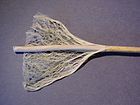
Synthetic CelluloseMineral
Wikimedia Foundation. 2010.
Synonyms:
Look at other dictionaries:
Cotton — Cot ton (k[o^]t t n), n. [F. coton, Sp. algodon the cotton plant and its wool, coton printed cotton, cloth, fr. Ar. qutun, alqutun, cotton wool. Cf. {Acton}, {Hacqueton}.] 1. A soft, downy substance, resembling fine wool, consisting of the… … The Collaborative International Dictionary of English
Cotton — ist der Familienname folgender Personen: Aimé Cotton (1869–1951), französischer Physiker Annie Cotton (* 1975), kanadische Sängerin und Schauspielerin Antony Cotton (* 1975), britischer Schauspieler Aylett R. Cotton (1826–1912), US amerikanischer … Deutsch Wikipedia
Cotton On — Group Type Privately owned Industry Fashion Founded Geelong, Australia Headquarters Geelong, Australia Key people Nigel Austin … Wikipedia
COTTON (A. A.) — COTTON AIMÉ AUGUSTE (1869 1951) Né à Bourg en Bresse, élève à l’École normale supérieure de 1890 à 1893, Aimé Auguste Cotton y enseigna de 1900 à 1922, après avoir été professeur à la faculté des sciences de Toulouse de 1895 à 1900. De 1920 à… … Encyclopédie Universelle
COTTON (J.) — COTTON JOHN (1584 1652) Le pasteur puritain qui allait devenir la plus grande figure de «la Plantation du Seigneur» en Nouvelle Angleterre est né en 1584. Le mouvement qui milite pour que l’Église d’Angleterre extirpe d’elle même les «reliques du … Encyclopédie Universelle
cotton — [kät′ n] n. [ME cotoun < OFr coton < (? via It cotone) Ar quṭun < ? Egypt] 1. the soft, white seed hairs filling the seedpods of various shrubby plants (genus Gossypium) of the mallow family, originally native to the tropics 2. a plant… … English World dictionary
cotton to — ˈcotton to [transitive] [present tense I/you/we/they cotton to he/she/it cottons to present participle cottoning to past tense cottoned to p … Useful english dictionary
COTTON — COTTON, plant mentioned under the name karpas (derived from the Sanskrit karpasa) in the Book of Esther (1:6) in the description of the magnificent ornamentation of Ahasuerus palace. In the Mishnah cotton is called ẓemer gefen ( vine wool ) as… … Encyclopedia of Judaism
Cotton — Cotton, Robert Bruce * * * (as used in expressions) Cotton Belt Cotton Club Cotton, John Cotton, sir Robert Bruce King Cotton Mather, Cotton … Enciclopedia Universal
Cotton — Cot ton, v. i. 1. To rise with a regular nap, as cloth does. [Obs.] [1913 Webster] It cottons well; it can not choose but bear A pretty nap. Family of Love. [1913 Webster] 2. To go on prosperously; to succeed. [Obs.] [1913 Webster] New,… … The Collaborative International Dictionary of English
cotton — ● cotton nom masculin (de W. Cotton, nom propre) Métier rectiligne qui tricote simultanément plusieurs panneaux avec augmentations et diminutions. Cotton (Aimé) (1869 1951) physicien français, spécialiste d électromagnétisme … Encyclopédie Universelle
Share the article and excerpts
Direct link
https://en-academic.com/dic.nsf/enwiki/22979 Do a right-click on the link above
and select “Copy Link”
Cotton
- Cotton
-

